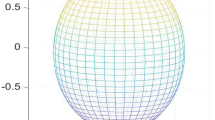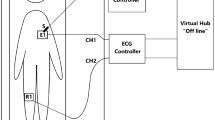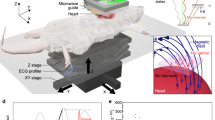Abstract
IN a volume conductor with an insulating boundary the integral of potential over the surface can be utilized to deduce the equivalent, internal generator. This communication deals with networks of resistors, collecting potentials over the surface of the body; it is an attempt to attain clinical information on the cardiac, equivalent generator. The input of the networks is fed by electrodes distributed on the wall of the chest, the output of the networks is feeding the measuring instrument. The time-varying potentials are distributed and superimposed in the network and recorded as vectorial electrocardiograms. The framework of resistors yields the reference system of the electrocardiographic leads between the output terminals and determines the lead vector relations. Thus, the vector representing the equivalent generator of the cardioelectric field is resolved into co-ordinates.
This is a preview of subscription content, access via your institution
Access options
Subscribe to this journal
Receive 51 print issues and online access
$199.00 per year
only $3.90 per issue
Buy this article
- Purchase on Springer Link
- Instant access to full article PDF
Prices may be subject to local taxes which are calculated during checkout
Similar content being viewed by others
References
Rijlant, P., Bull. Acad. Roy. Méd., Sixth Series, 22, 464 (1957).
Kowarzykowie, H., and Z., Spatial Vectorcardiography (Pergamon Press, 1961).
Author information
Authors and Affiliations
Rights and permissions
About this article
Cite this article
KOWARZYK, H., KOWARZYK, Z. & JAGIELSKI, J. Spatial Substitutes of the Lead Vector Triangle. Nature 206, 1365–1367 (1965). https://doi.org/10.1038/2061365a0
Issue Date:
DOI: https://doi.org/10.1038/2061365a0
Comments
By submitting a comment you agree to abide by our Terms and Community Guidelines. If you find something abusive or that does not comply with our terms or guidelines please flag it as inappropriate.



